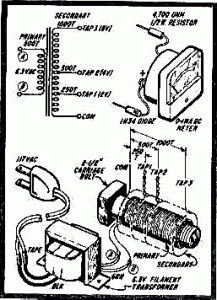Power Transformers
Just about everywhere there’s AC you’ll find a power transformer stepping the voltage up or down. It’s a simple job to wind your own transformer on a large carriage bolt to see and get the feel of transformer action.
To keep our experiment shock free, we use a 6.3 volt filament transformer as a source of operating voltage. For the primary, wind 500 turns of No. 28 enameled wire in even layers as shown. The beginning lead of the secondary, which is wound on top of the primary, is called the com, or common lead. Wind 250 turns, bring out a 6-inch loop for tap 1, wind 250 more turns, bring out a loop for tap 2, then wind 500 more turns for tap 3. Connect the primary leads to the secondary of the filament transformer and you’re ready to go.
You can make measurements with a 0-10VAC voltmeter (or a 0-1mA DC milliameter by adding the diode and resistor as shown). Plug in the filament transformer and measure the primary voltage at A and B. It should be about 6 volts. Now read the secondary voltage across the com and tap 1 leads. It should be about 2 to 3 volts. This shows that voltage has been stepped down. And the amount of step down is equal to the ratio of primary and secondary turns. Since the secondary we used has half the number of primary turns, the voltage is half. Move the meter to tap 2 and the voltage will about the same as the primary voltage because the turns ratio is one to one. Connect the meter to tap 3 and the voltage will be twice the primary voltage because the secondary has twice the number of primary turns. Secondary voltages are not always in proportion to the ratio of turns because of poor magnetic coupling between the primary and the secondary. Transformer action takes place because current changes in the primary create an expanding and collapsing magnetic field. As lines of this field cut across the secondary windings, they induce a current in them. The carriage bolt, however, is not efficient enough to transfer all the energy. To improve the coupling, lay a screwdriver flat against the secondary. Now angle the screwdriver so its tip touches one end of the bolt. The voltage should increase because of the improved coupling. Another transformer loss occurs because the magnetic field induces current in the bolt and this just produces heat. Commercial transformer cores are made of iron laminations which provide a good path for the magnetic lines of force but resist current flow. The transformer’s turns ratio also changes current but in the opposite way. If a 6-volt primary is rated at 1 amp, the available current in a secondary with twice the number of turns will be .5A. Stepping down the voltage will increase the current and vice versa. -H.B. Morris-
Electronics Illustrated
Hopefully you get from this article that different ‘grades’ of carriage bolts yield a more efficient magnetic coupling, and iron (as used in commercial transformers) gives even better efficiency. With your windings right on top of each other (separated only by the lacquer insulation), the ‘bobbin issue’ becomes moot. Try interleaving your windings if you want, and find out first hand if the efficiency improves (it doesn’t). What makes transformer ‘A’ any different/better than transformer ‘B’ are parameters that aren’t taught in college electronics courses. You won’t find any of this information spelled out clearly in The Radiotron Designer’s Handbook either, which is probably why no tube guru seems to know it.

